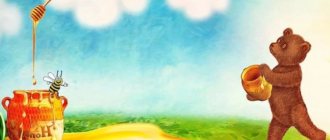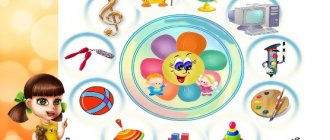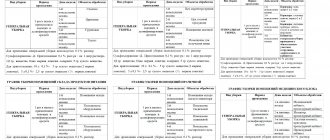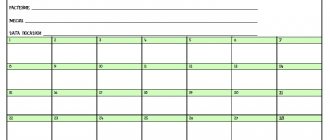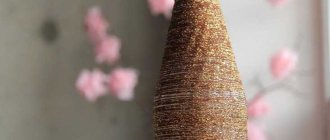Features of a child with ODD level I, ODD level II. Alalia (organization of RPPS, working methods)
Author: Tatyana Aleksandrovna Korekova , Category: Consultations for teachers · 2/2/2018 12:57:00
Good afternoon, dear teachers. At the first meeting, Olga Valerievna talked about children with disabilities and disabilities. The group of children with disabilities is not homogeneous; it includes children with various developmental disorders, the severity of which may vary. Let us remember what developmental disorders such children have.
Read all »
TRIZ Saturday No. 13: Master class on using the little people method
18/1/2017
Hello readers!
And one more story about the next “TRIZ Saturday”. This time we tried a new format: a master class on TRIZ methods. In one lesson, we get acquainted with some method, use it to solve some scientific problem, and then try to solve some of our own life problems using this method.
The point: to make each lesson complete and unrelated to the other, so that both children who came for the first time and “old-timers” could participate.
We had our sights set on the method of little men - MMC. Using this method, you can represent any object, their system or even a process. The key word here is REPRESENT. Often the words atoms and molecules do not convey a clear visual image, especially for children. In addition, the participation of little people greatly reduces psychological inertia: their very appearance is already a little fabulous and unusual. Therefore, many people relax and begin to think in ways that they would never do if they imagined atoms and molecules.
Introduction to the MMC method:
The most enjoyable and interesting game for children is to turn into these little people themselves - liquid, solid or gaseous.
We immediately tried to model some processes with the schoolchildren:
- “plunging” a finger into the table
- dipping your finger in water,
- immersion in an empty glass of air.
Many inventors came up with something when they began to observe the process not from the outside, but imagined it and became a full-fledged participant. This is a very useful exercise for children, developing the ability to imagine and think in images.
The next way to introduce people is to draw them. Here I encountered a difficulty: drawing objects with the help of little people was difficult for many. Many people slipped into drawing a non-homogeneous substance, rather than people. For me, this means that not everyone understood the meaning and what advantage is presented by the presentation of men, and not bricks, for example. This means that this advantage must be shown very, very clearly.
The culmination of our master class was an experiment that we tried to understand and explain with the help of little people. Quite simple, but it was the one that was supposed to push the guys to the right reasoning when solving the next problem.
Experiment #1:
They took some water into the bag and tied it tightly. Put it in a jar and pierce the bag. As a result, the water first begins to flow out like a fountain, and then stops. Why?
With little people, this experiment is explained very simply and, most importantly, is understandable for children.
At first, the little men feel very cramped in the bag of water. It looks like a stuffy room with a lot of people crammed into it. Everyone wants to go out. And when they open the door (they make a puncture), those little men who are standing nearby immediately begin to get out. And those standing far from the entrance are waiting for their turn. But at some point, the little people outside become as cramped as the ones inside. There is no point in going out anymore and the little people stop coming out of the bag.
Communicating vessels, pressure - all this will be studied only in high school in physics lessons. But now it is already possible to explain many processes to children in an accessible language, and most importantly, GIVE them a tool with which they can explain many things around them. And one more thing: then, after 5-6 years in physics lessons, all these processes and formulas will not only be memorized by children, but will be understood on an absolutely natural level.
Experiment No. 2
Throw a small paper ball into a glass of water. We pour water from glass to glass and the ball also moves with the flow of water.
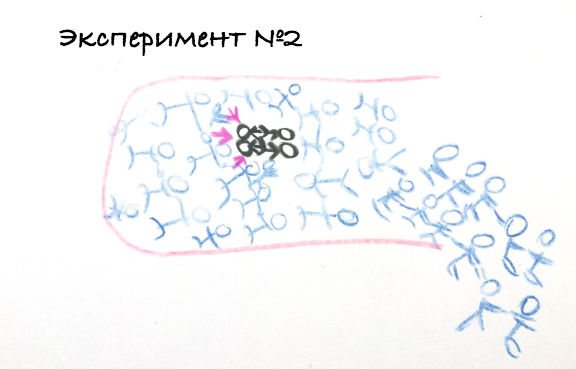
Again we simulate the situation with the help of little people. You find yourself in a crowd of people (those who have been on the subway during rush hour understand very well). It is very difficult to remain still or go backwards. The simplest thing is to go along with everyone. The same thing happens to our little people. The liquid ones push the solid ones and carry them forward along with them.
Research problem:
A motionless anglerfish lures its prey to itself using a flashlight on one of its spines. One moment and the prey is in the mouth of the anglerfish. How if the fish DOESN'T MOVE?
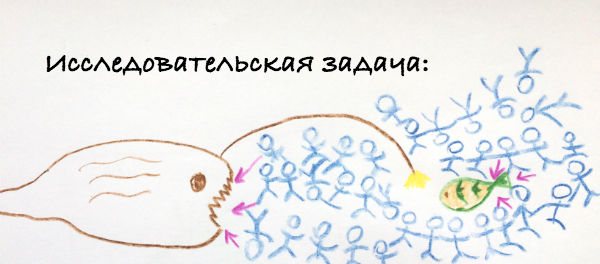
Here are the steps children must go through to solve the problem:
- Drawing fish and prey. But that is not all? Do we need to guess about the third participant in our process? These are little water people! We draw them too.
- Now we need to understand how these little men can help us? Just like in experiment No. 2, they can transfer the fish directly into their mouth!
- And the last idea: how to make the water man move? This is the message for experiment No. 1. After all, the little people there began to move very actively when they opened the “entrance”
MMC in children's lives:
And at the end, I tried to invite the children to find their own problem. From my life. I think this is a very important part of the lesson, because many people already know how to fantasize and come up with ideas on abstract topics and very well. But they don’t even see their own problems, they don’t know how to translate them into tasks, much less solve them. But this is exactly what TRIZ is needed for!
First I told them a short story about the boy Denis. During the story, the children had to find his problems and turn them into tasks.
Then everyone tried to describe their day and remember some problem, and then turn it into a task.
- Problem: Little brother destroys Lego castles. Task: How can I make my brother stop touching my buildings?
- Problem: The younger brother screams and interferes with homework. Task: How to make your brother’s scream help you do your homework?
- Problem: After cutting, there are a lot of scraps on the floor. How to make sure that after cutting there are NO scraps.
It turned out chaotic, but overall good. Everyone tried to solve their problem with the help of little people and modeling the process. This was already quite difficult. And for now, the current skill is still turning problems into tasks. This is what we will continue to train on.
Sincerely, Nesyutina Ksenia
Leave your comment
×Cancel reply
MAGAZINE Preschooler.RF
Topic: “Modeling the world around us with little people”State budgetary preschool educational institution kindergarten No. 90 of the Kalininsky district of St. Petersburg
Directly - educational activities on cognitive-speech development and environmental education. preparatory group.
Program content:
- Develop complex forms of dialogic speech: detailed conclusions and judgments, inferences. Practice coherent speech and precise use of words.
- .Teach children the ability to listen to a friend, teacher, restrain themselves, and answer questions posed.
- Help the child develop a holistic understanding of the world around him, develop speech, logical, systematic thinking
To deepen children's understanding that everything around them consists of microscopic particles, which we will call “Little People”
,
(TRIZ elements*)
.
Reveal that ice is a solid substance, floats, and consists of water. Determine that ice melts from heat, that water freezes in the cold and takes the shape of the container in which it is located. Identify the properties of the stone (dry, hard, cannot be sculpted from it, cannot be divided into parts)
. Detect air in the surrounding space and determine its property - invisibility.
Use the object survey model*.
4. Teach children the ability to listen to a friend, teacher, restrain themselves, and answer questions posed.
Preliminary work:
- Observation of objects, what objects can be: (solid, liquid, gaseous ball, inflated with gel, hanging in the air without falling)
- Observation of the transformation of some solid objects into liquid, for example, ice cream, melting into liquid, and vice versa, liquid into solid (water in the cold)
.
Equipment and materials: various stones, boxes of sand, a model for examining objects, picture diagrams, a balloon, a bowl of water, an empty plastic bottle, sheets of paper, pieces of ice, ice molds. Models of people.
"Tough Men"
"liquid men"
"gaseous men"
A. Tukarov
Baby sing along with us.
If you jump from a tower in winter, you will, of course, get bumps. Know that the water was solid, You will answer without difficulty. Well, if you jump into the water in very warm weather, you will be wet to the skin: In summer, the ice can be liquid. Here's a leapfrog: Here there is ice, and here there is water. Think about it and answer: Is liquid a river or solid? Let's scoop up some water from the river and put it on the stove to heat. Steam will fill our entire house, but we won’t find water. Here's a leapfrog: There's steam here. And then water. Liquid - river or gas? You answer us right away. And water, and ice, and steam, Both young and old will tell you This is all water, You will remember forever!
V-l: Guys, Dunno brought us something in a box and asks us to tell him what it is. The children are looking. - What did Dunno bring us?
Children are stones.
V-l: - How are these stones similar?
Children act in accordance with the model: they press, knock.
All stones are hard.
Vs: - Pay attention to what kind of little people our stones are made of. I demonstrate a model of solids. Look how tightly our little people hold hands. All solid objects are made of such little men. What are the hardest objects you know?
The children answer.
V-l: If the solid men of stone separate their hands, what can happen.
Children: If you throw such a stone, it will break.
Vs: So, when the stone breaks, the solid men will come apart? How do the little people behave in the rubble?
Children: They are still hard. Holding each other's hands tightly
Game with pebbles “Post a picture”
—
Dunno hands out picture diagrams and offers to lay them out from pebbles. Children take trays of sand and lay out pictures according to the diagram.
Vs: - What do you think is the difference between liquid people and solid ones?
Children: - They don’t hold each other’s hands, but even if they do, it’s easy to tear them off. What kind of liquid people are there in the world?
Children: - Water, soup.
Vs: - No, there are hard people in the soup.
Children: - Cocktail, yolk, jellyfish, kefir, milk, sea, jam, slush, metal when it is melted, semolina, pancakes until they are fried.
V-l; I show a model of liquid substances. You see, the little men only hold each other with their elbows, so it’s easy to separate them.
I set out a bowl of water and throw ice in it. The children are looking.
How can you get multi-colored ice? Children: - Add paint to the water and put it in the cold.
Vs: - That's right. The liquid people will again hold each other with their elbows and our water will turn into ice. Let's do that. Place colored water in the cold.
V-l: I demonstrate a model of gaseous substances. – What do you think, what kind of man is this?
Children: Gas Man. Such little men run in different directions, and nothing can stop them.
Dunno asks a riddle about air.
It goes through the nose into the chest and goes back.
He's invisible and yet
We cannot live without him.
(Air)
Vs: What do we inhale through our noses? What is air? What is it for? Can we see it? Where is the air? How to find out if there is air around?
- Game exercise “Feel the air”
- children wave a sheet of paper near their face. How do we feel? We don't see air, but it surrounds us everywhere. - Do you think there is air in an empty bottle? How can this be checked? We lower the empty transparent bottle into a bowl of water until it begins to fill with water. What's happening? Why do bubbles come out of the neck? This water displaces the air from the bottle. Most objects that appear empty are actually filled with air.
- Name the objects that we fill with air. Children inflate balloons. What do we fill the balloons with?
Air fills every space, so nothing is empty.
V-l; Today we met with the various little people who make up everything around us. Do you remember what they are called? Children's answers. Well done, everyone was attentive, remembered everything and listened.
| Next > |
